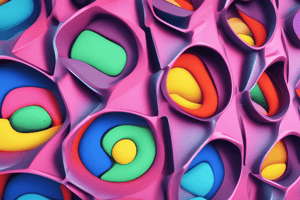Podcast
Questions and Answers
What do capital letters represent in Punnett squares?
What do capital letters represent in Punnett squares?
- Dominant alleles
- First generation alleles (correct)
- Second generation alleles
- Recessive alleles
In genetics, what do lowercase letters represent in allele combinations?
In genetics, what do lowercase letters represent in allele combinations?
- Dominant alleles
- First generation alleles
- Recessive alleles
- Second generation alleles (correct)
How are alleles determined at each intersection in a Punnett square?
How are alleles determined at each intersection in a Punnett square?
- Based on the parent's preference
- By random selection
- Through laws of probability and Mendelian genetics (correct)
- By alphabetical order
If a parent has the genotype 'Rr', what alleles can they contribute to their offspring?
If a parent has the genotype 'Rr', what alleles can they contribute to their offspring?
What does the phenotypic ratio reflect in Mendelian genetics?
What does the phenotypic ratio reflect in Mendelian genetics?
Flashcards are hidden until you start studying
Study Notes
Understanding Punnett Squares
Punnett squares are a fundamental tool used in genetic analysis to predict the possible genotypes of offspring from two parents with known genotypes. They were introduced by English botanist Reginald Punnett as part of his work on Gregor Mendel's principles of inheritance. These squares allow biologists to visualize the combination of genes from both parents and predict the likelihood of certain traits being passed down to their descendants.
Genetics Inheritance
Genetic inheritance refers to the passing down of specific characteristics or traits from parent to offspring through DNA molecules called chromosomes. This occurs during sexual reproduction when the male gamete (e.g., sperm) fuses with the female gamete (egg) to form a new individual. Each gamete carries half of its parent's genetic material, ensuring that the offspring receives one set of chromosomes from each parent.
Using Punnett Square Calculations
To create a Punnett square, you list the different alleles (versions of a gene) present in the parents across the top and down the side of a grid. For example, if a human has red hair (genotype 'RR') and a partner has blonde hair (genotype 'rr'), they could have children with different hair colors depending on how their alleles combine. If we fill out the square, it would look like this:
| Paternal Alleles
R | R x r R x r R x r R x r ...
rr | r x R r x R r x R r x R ...
The first generation is represented by capital letters, while lowercase letters represent the second generation. At each intersection of a row and column, we can determine which alleles will blend together based on the laws of probability and Mendelian genetics.
Alllele Combinations
An important aspect of using Punnett squares is understanding that each parent contributes one allele to their offspring. For example, if a parent has the genotype 'Rr', they can contribute either the dominant 'R' or recessive 'r' allele. When mating with another person who also contributes an uppercase or lowercase letter, the resulting progeny will receive one of those alleles from each parent, leading to a variety of potential outcomes.
Mendelian Genetics and Phenotypic Ratios
Mendelian genetics explains how the combination of parental alleles determines the genotypes of their offspring according to simple rules. These genetic principles can be observed in plants and animals, allowing researchers to make predictions about the outcome of crosses between individuals based solely on the knowledge of their genotypes. As mentioned earlier, the phenotypic ratio reflects the actual physical appearance of the organism, such as color or height.
By understanding these concepts and applying them to Punnett squares, scientists can better predict and understand the transmission of genetic information within populations. This tool helps researchers explore questions related to evolution, adaptation, and disease resistance.
Studying That Suits You
Use AI to generate personalized quizzes and flashcards to suit your learning preferences.




